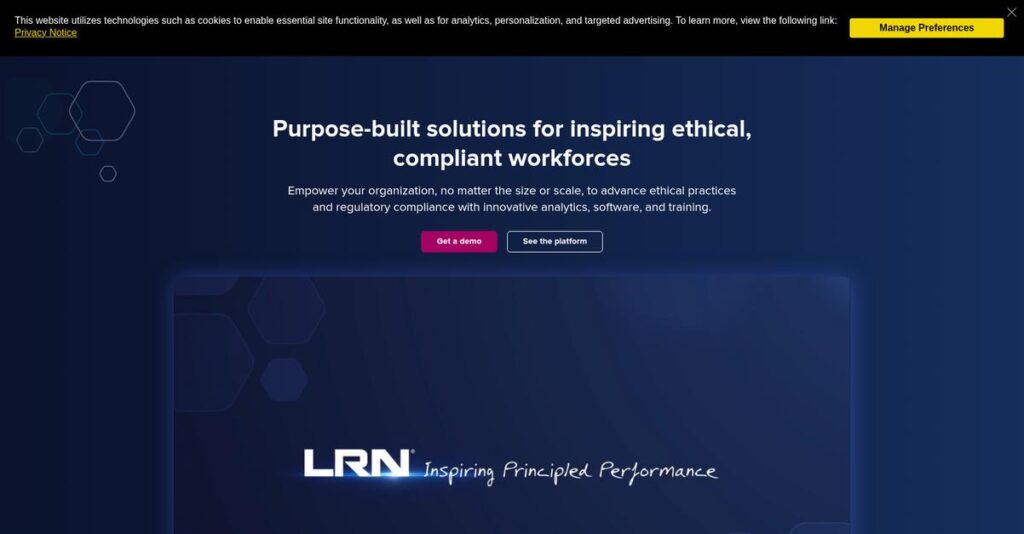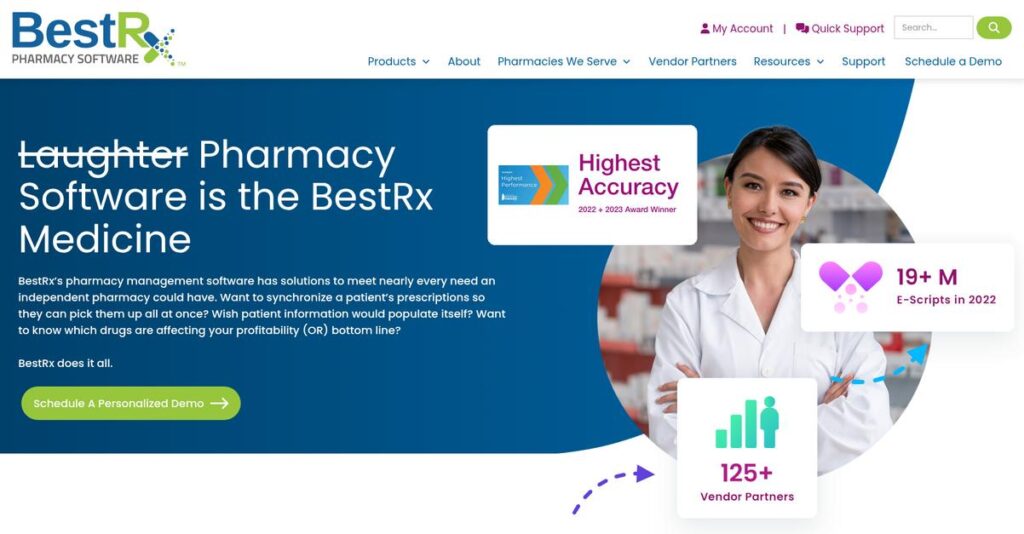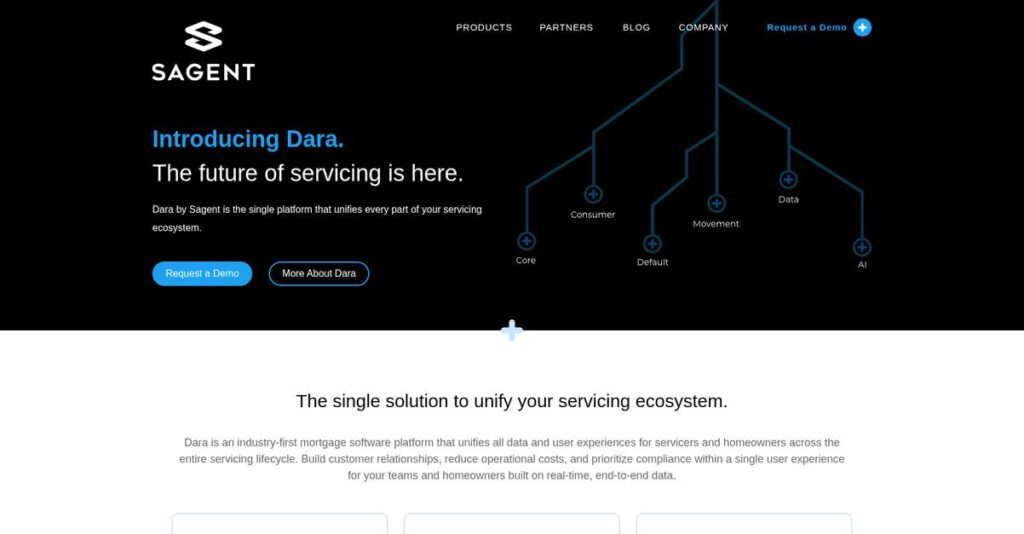Construction chaos slowing your projects again?
If you’re looking into Procore, you’re probably overwhelmed by scattered project data, communication breakdowns, and endless spreadsheets making it hard to keep your jobs on track.
The real pain is that you’re constantly putting out fires instead of building—losing time, money, and your sanity to daily mistakes or missing information.
That’s why I took a deep dive into Procore’s unified management platform, analyzing how it connects your field and office teams, brings all your documents and updates into one dashboard, and actually keeps everyone on the same page—no matter the project size.
In this review, I’ll break down how Procore can minimize errors and keep your projects moving forward with better visibility and control.
You’ll see in this Procore review how the features, pricing, real-world results, and alternatives stack up so you can confidently compare it to other choices.
Read on for the features you need to streamline your next construction project and finally get ahead of project headaches.
Let’s get started.
Quick Summary
- Procore is a cloud-based construction management platform that centralizes project communication, documentation, and financial tracking.
- Best for mid-sized to large construction companies needing comprehensive project and financial oversight.
- You’ll appreciate its user-friendly interface that connects office and field teams while providing real-time updates and strong financial controls.
- Procore offers custom pricing based on your project volume, with no free trial but demo options available on request.
Procore Overview
Procore has been a dedicated construction management software provider since its 2002 founding in California. Their entire mission is to connect every single project stakeholder on one global platform.
While they serve the entire market, I find their true sweet spot is helping general and specialty contractors scale. This practical focus on usability for actual builders makes the platform uniquely approachable across your whole organization.
Their recent acquisitions in estimating and AI signal a clear and aggressive strategy to own the complete project lifecycle, a critical point we’ll explore further through this Procore review.
- 🎯 Bonus Resource: While we’re discussing the complete project lifecycle, understanding PLC programming software is equally important for project success.
Unlike competitors that are often too niche or overwhelmingly complex, Procore’s core advantage is its all-in-one yet remarkably intuitive platform. It’s a comprehensive system that your field teams will actually use daily.
Today, they work with thousands of the world’s leading owners, general contractors, and specialty contractors, giving them immense credibility and a deep understanding of industry best practices.
I see their current business strategy as creating the one central operating system for the construction industry, effectively replacing your fragmented spreadsheets and single-purpose apps. This directly addresses the critical need for a single source of project truth.
Let’s dive into the platform’s features.
Procore Features
Still wrestling with fragmented construction software?
Procore’s integrated solutions simplify every project stage, from planning to completion. Here are the five core Procore solutions that bring efficiency to your construction operations.
1. Project Management
Are project schedules constantly slipping?
Disjointed communication and scattered documents can derail your construction projects. This often leads to frustrating delays and cost overruns.
Procore’s Project Management centralizes schedules, tasks, RFIs, and submittals, giving you a clear, real-time view of progress. What I love about this is how easy it is to assign tasks and track completion directly within the platform. This solution helps ensure everyone is working with the latest information.
This means you can streamline workflows and keep your projects on track, avoiding those costly last-minute scrambles.
- 🎯 Bonus Resource: While we’re discussing design and planning tools, understanding best furniture design software might offer a different perspective.
2. Financial Management
Struggling to keep project finances in check?
Lack of real-time financial visibility can lead to unexpected budget overruns and poor cash flow. This often leaves you guessing about project profitability.
Procore’s Financial Management provides timely insights into project costs, budgets, and forecasts by centralizing accurate data. From my testing, its ability to track labor costs and productivity in real-time is truly impressive. This solution integrates with ERPs like Sage 300 CRE, eliminating manual data entry.
So you can monitor budgets with precision, control financial risks, and make informed decisions that improve your project’s bottom line.
3. Field Productivity
Is your office team disconnected from the jobsite?
Manual data entry and delayed communication from the field can hinder productivity and decision-making. This often results in incomplete information and wasted time.
Field Productivity connects office and field teams with easy-to-use mobile tools, enabling real-time data capture. Here’s what I found: the bulk timesheet entry and GPS logging are game-changers for accountability. This feature helps field staff document out-of-scope work and capture progress photos instantly.
This means you get real-time visibility into labor and progress, reducing administrative burden and making your on-site teams more efficient.
4. Quality & Safety
Worried about jobsite incidents and compliance?
Managing safety and quality manually can be complex, leading to missed issues and potential risks. This can expose your business to unnecessary liabilities.
Procore’s Quality & Safety provides tools to track workplace incidents, notify stakeholders of safety issues, and manage compliance. This is where Procore shines in helping teams build with safety in mind, though specific practical details require deeper exploration. This feature aims to create a safer work environment for everyone.
So you can proactively address safety concerns, build a culture of compliance, and minimize risks on your construction projects.
5. Document Management
Tired of hunting for the latest project drawings?
Scattered documents and version control issues can lead to costly errors and miscommunication on projects. This often means teams work from outdated information.
Procore’s Document Management centralizes all project documents, including plans, contracts, and photos, with robust version control. What I love about this is its powerful OCR technology for digitizing documents, ensuring everyone accesses the latest version. This feature eliminates the need for emailing large drawing sets.
This means your entire team can always access a single source of truth, avoiding confusion and improving collaboration across the board.
Pros & Cons
- ✅ Comprehensive, integrated platform for end-to-end project management.
- ✅ User-friendly interface and highly praised for ease of use.
- ✅ Centralized communication and real-time data visibility across projects.
- ⚠️ Higher cost may be a barrier for smaller projects or businesses.
- ⚠️ Extensive features can feel overwhelming for users with simpler needs.
- ⚠️ Mobile app can experience occasional crashes or performance issues.
You’ll actually appreciate how these Procore features work together to create a unified construction management platform rather than a collection of disconnected tools.
\n\n
Procore Pricing
Worried about software costs spiraling out of control?
Procore pricing is entirely custom, based on your specific needs and project volume, meaning you won’t find fixed tiers but rather a tailored quote.
Cost Breakdown
- Base Platform: Custom quote
- User Licenses: Volume-based pricing
- Implementation: Varies by complexity
- Integrations: Varies by complexity
- Key Factors: Products chosen, Annual Construction Volume (ACV)
1. Pricing Model & Cost Factors
Understanding custom quotes.
Procore’s pricing model is not publicly disclosed but hinges on a custom quote. What I found regarding pricing is that it depends on the specific products you choose (e.g., Project Management, Financials) and your company’s Annual Construction Volume (ACV). More features and higher ACV will increase your cost.
From my cost analysis, this means your budget commitment directly aligns with the scale of your construction operations.
- 🎯 Bonus Resource: While we’re discussing construction operations, understanding how to future-proof your fleet operations is equally important.
2. Value Assessment & ROI
Does the cost justify the value?
Procore’s comprehensive platform aims to centralize all project data, which can significantly reduce errors and improve efficiency. Budget-wise, what stood out is how this leads to substantial long-term ROI by minimizing costly rework and disputes often found in siloed systems.
For your business, this means investing in Procore could lower overall project costs and enhance profitability over time.
3. Budget Planning & Implementation
Prepare for comprehensive budgeting.
Given the custom Procore pricing, you’ll need to engage with their sales team to get an accurate quote tailored for your business. From my research, Procore can be cost-prohibitive for smaller companies due to its extensive features and volume-based pricing structure.
So for your business, plan for a significant investment, especially if your ACV is high or you need multiple modules.
My Take: Procore’s pricing strategy caters to mid-to-large construction enterprises that need a comprehensive, scalable platform and are prepared for a significant, but valuable, investment.
The overall Procore pricing reflects premium enterprise value for large-scale construction operations.
Procore Reviews
What do real customers actually think?
Analyzing Procore reviews provides crucial insights into real-world user experiences, helping you understand what current customers genuinely think about this construction management software.
1. Overall User Satisfaction
Users seem largely satisfied with Procore.
From my review analysis, Procore consistently achieves high ratings, averaging 4.5-4.6 stars on major review platforms like G2 and Capterra. What stands out in user feedback is the software’s ability to centralize project data, creating a single source of truth across teams.
This indicates you can expect a highly functional and well-regarded solution for your construction projects.
2. Common Praise Points
Its comprehensive features are widely loved.
Users frequently praise Procore for being an all-in-one solution, from bidding to closeout. What I found in user feedback is how its centralized communication streamlines workflows and keeps all project stakeholders on the same page, significantly improving efficiency.
This means you’ll likely find it effective for managing diverse aspects of your construction projects.
3. Frequent Complaints
Cost and complexity often emerge as issues.
While powerful, some reviews highlight Procore’s high cost as a significant barrier, especially for smaller businesses. What’s often mentioned in customer feedback is how the extensive feature set can feel overwhelming or like “feature bloat” for users with simpler needs.
These issues suggest considering your budget and specific requirements carefully before committing.
- 🎯 Bonus Resource: While exploring various software solutions, you might also be interested in my guide on best DJ software to master your mix.
What Customers Say
- Positive: “Procore is the most user-friendly construction management software that I have ever used.” (Small Business User)
- Constructive: “The platform offers a staggering array of tools…many of which go unused.” (G2 Reviewer)
- Bottom Line: “I don’t think Procore gets enough credit for how amazing their support is.” (CEO)
Overall, Procore reviews reveal a powerful, highly-rated solution, though cost and feature complexity warrant your consideration.
Best Procore Alternatives
Which Procore alternative truly fits your needs?
The best Procore alternatives include several strong options, each better suited for different business situations, project scales, and budget priorities in construction.
1. Autodesk Construction Cloud
Heavily reliant on BIM and design collaboration?
Autodesk Construction Cloud excels if your firm prioritizes deep integration between design and construction processes, leveraging its advanced BIM capabilities. From my competitive analysis, Autodesk offers superior design and document integration, making it a powerful alternative for enterprise general contractors.
Choose this alternative when BIM coordination and design-to-field workflows are your absolute priority.
- 🎯 Bonus Resource: While we’re discussing integrating design tools, you might find my guide on music notation software helpful for creative pursuits.
2. CMiC
Need robust financial and accounting integration?
CMiC shines as a comprehensive construction ERP system, especially for large enterprises needing deep financial controls, job costing, and integrated accounting. What I found comparing options is that CMiC offers superior financial management and ERP integration, a strong alternative if unified accounting is critical.
Consider CMiC when enterprise-level financial oversight and unified accounting are paramount for your complex projects.
3. Fieldwire (by Hilti)
Seeking streamlined field operations?
Fieldwire focuses intently on field productivity, offering an intuitive, mobile-first interface for task management, plan viewing, and site collaboration. Alternative-wise, Fieldwire provides excellent mobile-first field management, making it appealing for quick adoption by less tech-savvy crews.
Choose Fieldwire if your primary need is robust, user-friendly field task management and office-to-field communication.
4. Buildertrend
Are you a home builder or remodeler?
Buildertrend is often recommended for residential contractors, offering an all-in-one project management solution specifically tailored to home building and remodeling. From my analysis, Buildertrend caters directly to residential contractors, providing a streamlined solution for smaller to mid-sized residential projects.
Opt for Buildertrend if your business is primarily residential construction, seeking a specialized, all-in-one platform.
Quick Decision Guide
- Choose Procore: Comprehensive, scalable platform for diverse construction projects
- Choose Autodesk Construction Cloud: Deep BIM and design-to-construction integration
- Choose CMiC: Robust financial and ERP integration for large enterprises
- Choose Fieldwire: Intuitive, mobile-first field operations and task management
- Choose Buildertrend: All-in-one solution for residential builders and remodelers
The best Procore alternatives depend on your specific business size and project requirements rather than a generic feature list.
Procore Setup
Is Procore implementation as daunting as it seems?
A Procore review shows that deployment success hinges on understanding its comprehensive nature. This section breaks down what your business needs to consider for a smooth Procore setup.
1. Setup Complexity & Timeline
Expect a nuanced deployment, not a flip-a-switch solution.
Procore’s initial setup can be complex due to its vast features and the need to tailor it to your specific workflows. From my implementation analysis, each company’s Procore setup can vary significantly, impacting how smoothly your team navigates it initially.
You’ll need to dedicate time for proper configuration and internal alignment to customize Procore effectively for your operations.
2. Technical Requirements & Integration
Be ready for necessary IT and integration efforts.
As a cloud-based platform, Procore needs a reliable internet connection, but its mobile app handles offline work. What I found about deployment is that its extensive App Marketplace and open API support integration with your existing accounting and scheduling systems.
Plan for IT readiness to manage integrations and ensure consistent data flow across your digital ecosystem.
3. Training & Change Management
User adoption requires focused effort and support.
Despite an intuitive interface, comprehensive training is crucial to fully leverage Procore’s capabilities, especially for advanced features. From my analysis, successful change management is vital to avoid overwhelming users with the extensive array of tools available within the platform.
Invest in well-structured training programs and identify internal champions to foster broad user acceptance and ongoing proficiency.
- 🎯 Bonus Resource: While discussing software adoption, understanding strategies to retain users and guard revenue is also key. My analysis of churn prediction software covers this in depth.
4. Support & Success Factors
Vendor support can be a true game-changer.
Procore is highly praised for its responsive and helpful customer support, which is critical during implementation and ongoing use. From my analysis, their 24/7 support is a significant advantage for troubleshooting issues and maximizing your investment.
Factor in proactive engagement with their support team and utilize their resources to ensure your deployment remains on track.
Implementation Checklist
- Timeline: Several months for full workflow integration
- Team Size: Dedicated project lead plus IT/operations staff
- Budget: Training and potential professional services
- Technical: Reliable internet and third-party integrations
- Success Factor: Comprehensive training and workflow customization
Overall, successful Procore setup requires understanding its depth, but its robust features and support streamline deployment for long-term project management efficiency.
Bottom Line
Is Procore right for your construction business?
My Procore review shows a powerful, comprehensive solution for construction companies that need to centralize project management, financial controls, and field-to-office communication effectively.
1. Who This Works Best For
Growing construction businesses seeking unified project management.
Procore is ideal for mid-sized to large general contractors, specialty contractors, and owners managing complex projects with diverse stakeholders. From my user analysis, companies struggling with disjointed workflows across various systems will find its unified platform transformative for their operations.
You’ll succeed if your business prioritizes real-time visibility, financial oversight, and streamlined collaboration across all project phases.
2. Overall Strengths
Unifying the entire construction project lifecycle.
The software excels by centralizing project information, documents, and communication, fostering seamless collaboration from pre-construction to closeout. From my comprehensive analysis, its robust document management and financial tracking tools significantly improve efficiency and reduce errors across the construction lifecycle.
These strengths mean your team gains unparalleled project oversight and control, leading to improved project delivery and profitability.
3. Key Limitations
Significant investment and extensive feature set.
Procore’s pricing can be a barrier for smaller companies, and its comprehensive features may feel overwhelming for businesses with simpler needs. Based on this review, some users report occasional mobile app glitches and limited offline functionality, impacting on-site productivity for field teams.
I find these limitations are often outweighed by the platform’s long-term value for growing businesses, rather than deal-breakers.
4. Final Recommendation
Procore is a strong recommendation.
You should choose this software if your business requires a scalable, all-in-one platform to streamline complex construction projects and enhance collaboration. From my analysis, Procore delivers exceptional value for mature operations focused on comprehensive project oversight and strong financial controls.
My confidence level is high for mid-to-large construction companies but drops for very small businesses with basic requirements.
Bottom Line
- Verdict: Recommended for comprehensive construction management
- Best For: Mid-sized to large general contractors and specialty contractors
- Business Size: Companies with 10-1,000+ employees managing complex projects
- Biggest Strength: Unified platform for entire construction project lifecycle
- Main Concern: High investment cost and extensive feature set complexity
- Next Step: Request a demo to evaluate specific module fit for your projects
This Procore review shows strong value for mid-to-large construction companies, while highlighting important investment and feature complexity considerations for your decision.






